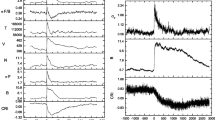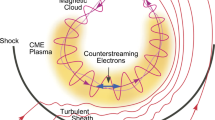Abstract
Interplanetary structures such as shocks, sheaths, interplanetary counterparts of coronal mass ejections (ICMEs), magnetic clouds, and corotating interaction regions (CIRs) are of special interest for the study of the transient modulation of galactic cosmic rays (GCRs). These structures modulate the GCR intensity with varying amplitudes and recovery-time profiles. It is known that ICMEs are mainly responsible for Forbush decreases in the GCR intensity. However, not all of the ICMEs produce such decreases in GCR intensity. We utilize GCR intensity data recorded by neutron monitors and solar-wind plasma/field data during the passage of ICMEs with different features and structures, and we perform a superposed-epoch analysis of the data. We also adopt the best-fit approach with suitable functions to interpret the observed similarities and differences in various parameters. Using the GCR-effectiveness as a measure of the cosmic-ray response to the passage of ICMEs, about half of the ICMEs identified during 1996 – 2009 are found to produce moderate to very large intensity depressions in GCR intensity. The ICMEs associated with halo CMEs, magnetic-cloud (MC) structures, bidirectional superthermal electron (BDE) signatures, and those driving shocks are 1.5 to 4 times more GCR effective than the ICMEs not associated with these structures/features. Further, the characteristic recovery time of GCR intensity due to shock/BDE/MC/halo-CME-associated ICMEs is larger than those due to ICMEs not associated with these structures/features.











Similar content being viewed by others
References
Abbrescia, M., Aiola, S., Antolini, R., Avanzini, C., Baldini, F.R., Bencivenni, G., et al.: 2011, Eur. Phys. J. Plus 126, 61.
Alves, M.V., Echer, E., Ganzalez, W.D.: 2011, J. Atmos. Solar-Terr. Phys. 73, 1380.
Ananth, A.G., Venkatesan, D.: 1993, Solar Phys. 143, 373. doi: 10.1007/BF00646494 .
Augusto, C.R.A., Kopkinen, V., Navia, C.E., Tsui, K.H., Shigueoka, H., Fauth, A.C., et al.: 2012, Astrophys. J. 759, 143.
Babu, A., Antia, H.M., Dugad, S.R., Gupta, S.K., Hayashi, Y., Kawakami, S., Mohanty, P.K., Nonaka, T., Oshima, A., Subramanian, P.: 2013, Astron. Astrophys. 555, A139.
Badruddin: 1998, Planet. Space Sci. 46, 1015.
Badruddin: 2002, Solar Phys. 209, 195. doi: 10.1023/A:1020937324310 .
Badruddin, Singh, Y.P.: 2009, Planet. Space Sci. 57, 318.
Badruddin, Venkatesan, D., Zhu, B.Y.: 1991, Solar Phys. 134, 203. doi: 10.1007/BF00148748 .
Badruddin, Yadav, R.S., Yadav, N.R.: 1986, Solar Phys. 105, 413. doi: 10.1007/BF00172057 .
Badruddin, Yadav, R.S., Yadav, N.R., Agrawal, S.P.: 1985, In: Jones, F.C., Admas, J., Mason, G.M. (eds.) Proc. 19th Int. Cosmic Ray Conf. La Jolla 5, 258. NASA conference Publication 2376.
Blanco, J.J., Catalan, E., Hidalgo, M.A., Medina, J., Garcia, O., Rodriguez-Pacheco, J.: 2013, Solar Phys. 284, 167. doi: 10.1007/s11207-013-0256-1 .
Burlaga, L.F., Sittler, E., Mariani, F., Schwenn, R.: 1981, J. Geophys. Res. 86, 6673.
Cane, H.V.: 1993, J. Geophys. Res. 98, 3509.
Cane, H.V.: 2000, Space Sci. Rev. 93, 55.
Cane, H.V., Richardson, I.G.: 2003, J. Geophys. Res. 108, 1156.
Cane, H.V., Richardson, I.G., von Rosenvinge, T.T.: 1996, J. Geophys. Res. 101, 21561.
Cane, H.V., Richardson, I.G., Wibberenz, G.: 1997, J. Geophys. Res. 102, 7075.
Chree, C.: 1912, Phil. Trans. Roy. Soc. London A 212, 75.
Dorotovic, I., Kudela, K., Lorenc, M., Rybansky, M.: 2008, Solar Phys. 250, 339. doi: 10.1007/s11207-008-9222-8 .
Dumbovic, M., Vršnak, B., Calagovic, J., Karlica, M.: 2011, Astron. Astrophys. 531, A91.
Dumbovic, M., Vršnak, B., Calagovic, J., Zupar, R.: 2012, Astron. Astrophys. 548, A28.
Farrugia, C.J., Berdichevsky, D.B.: 2004, Ann. Geophys. 22, 3679.
Forbush, S.E.: 1937, Phys. Rev. 31, 1108.
Gopalswamy, N., Yashiro, S., Akiyama, S.: 2007, J. Geophys. Res. 112, A06112.
Gopalswamy, N., Lara, A., Yashiro, S., Kaiser, M.L., Howard, R.A.: 2001, J. Geophys. Res. 106, 29207.
Gosling, J.T.: 1990, In: Russel, C.T., Priest, E.R., Lee, L.C. (eds.) Physics of Magnetic Flux Ropes, Geophys. Monogr. 58, AGU, Washington, 343.
Gosling, J.T.: 1996, Annu. Rev. Astron. Astrophys. 34, 35.
Gosling, J.T., Baker, D.N., Bame, S.J., Feldman, W.C., Zwickl, R.D., Smith, E.J.: 1987, J. Geophys. Res. 92, 8519.
Gupta, V., Badruddin: 2009, Astrophys. Space Sci. 312, 185.
Iucci, N., Parisi, M., Signorini, C., Storini, M., Villoresi, G.: 1989, Astron. Astrophys. Suppl. 81, 367.
Jian, L., Russel, C.T., Luhmann, J.G., Skoug, R.M.: 2006, Solar Phys. 239, 393. doi: 10.1007/s11207-006-0133-2 .
Jordan, A.P., Spence, H.E., Blake, J.B., Shaul, D.N.A.: 2011, J. Geophys. Res. 116, A11103.
Kahler, S.W., Reames, D.V.: 1991, J. Geophys. Res. 96, 9419.
Kane, R.P.: 2010, Ann. Geophys. 28, 479.
Klein, L.W., Burlaga, L.F.: 1982, J. Geophys. Res. 87, 613.
Kudela, K.: 2012, In: Lazar, M. (ed.) Exploring the Solar Wind 13, Intech, Rijeka, 285.
Kudela, K., Storini, M., Hofer, M.Y., Belov, A.: 2000, Space Sci. Rev. 93, 153.
Lepping, R.P., Burlaga, L.F., Tsurutani, B.T., Ogilvie, K.W., Lazarus, A.J., Evans, D.S., Klein, L.W.: 1991, J. Geophys. Res. 96, 9425.
LeRoux, J.A., Potgieter, M.S.: 1991, Astron. Astrophys. 243, 531.
Liu, Y., Richardson, J.D., Belcher, J.W., Kasper, J.C., Skoug, R.M.: 2006, J. Geophys. Res. 111, A09108.
Lockwood, J.A.: 1971, Space Sci. Rev. 12, 658.
Lockwood, J.A., Webber, W.R., Debrunner, H.: 1991, J. Geophys. Res. 96, 11587.
Marcz, F.: 1992, Planet. Space Sci. 40, 979.
Mavromichalaki, H., Preka-Papadema, P., Liritzis, I., Petropoulos, B., Kurt, V.: 2003, New Astron. 8, 777.
Modzelewska, R., Alania, M.V.: 2012, Adv. Space Res. 50, 716.
Nagashima, K., Sakakibara, S., Fujimoto, K., Tatsuoka, R., Morishita, I.: 1990, Nuovo Cimento 13C, 551.
Oh, S.Y., Yi, Y.: 2009, J. Geophys. Res. 114, A11102.
Oh, S.Y., Yi, Y.: 2012, Solar Phys. 280, 197. doi: 10.1007/s11207-012-0053-2 .
Oh, S.Y., Yi, Y., Kim, Y.H.: 2008, J. Geophys. Res. 113, A01103.
Quenby, J.J., Mulligan, T., Blake, J.B., Mazur, J.E., Shaul, D.: 2008, J. Geophys. Res. 113, A10102.
Rao, U.R.: 1972, Space Sci. Rev. 12, 719.
Richardson, I.G., Cane, H.V.: 2010, Solar Phys. 264, 189. doi: 10.1007/s11207-010-9568-6 .
Richardson, I.G., Cane, H.V.: 2011, Solar Phys. 270, 609. doi: 10.1007/s11207-011-9774-x .
Reames, D.V., Kahler, S.W., Tylka, A.J.: 2009, Astrophys. J. Lett. 700, L196.
Sabbah, I., Kudela, K.: 2012, J. Geophys. Res. 116, A041303.
Simpson, J.A.: 1954, Phys. Rev. 94, 426.
Singh, Y.P., Badruddin: 2006, J. Atmos. Solar-Terr. Phys. 68, 803.
Singh, Y.P., Badruddin: 2007, J. Geophys. Res. 112, A02101.
Subramanian, P., Antia, H.M., Dugad, S.R., Goswami, U.D., Gupta, S.K., Hayashi, Y., et al.: 2009, Astron. Astrophys. 494, 1107.
Usoskin, I.G., Braun, I., Gladysheva, G.G., Horandel, J.R., Jamsen, T., Kovaltsov, G.A., Starodubtsev, S.A.: 2008, J. Geophys. Res. 113, A07102.
Venkatesan, D., Badruddin: 1990, Space Sci. Rev. 52, 121.
Venkatesan, D., Badruddin, Ananth, A.G., Pillai, S.: 1992, Solar Phys. 137, 345. doi: 10.1007/BF00161855 .
Wawrzynczak, A., Alania, M.V.: 2010, Adv. Space Res. 45, 622.
Wibberenz, G., LeRoux, J.A., Potgieter, M.S., Bieber, J.W.: 1998, Space Sci. Rev. 83, 309.
Yu, X.X., Lu, H., Le, G.M., Shi, F.: 2010, Solar Phys. 263, 223. doi: 10.1007/s11207-010-9522-7 .
Zhang, G., Burlaga, L.F.: 1988, J. Geophys. Res. 93, 2511.
Zhang, J., Richardson, I.G., Webb, D.F., Gopalswamy, N., Huttunen, E., Kasper, J.C., Nitta, N.V., Poomvises, W., Thomson, B.J., Wu, C.C., Yashiro, S., Zhukov, A.N.: 2007, J. Geophys. Res. 112, A10102.
Acknowledgements
Useful catalogs of ICMEs/CMEs/magnetic clouds prepared and published/displayed on websites (especially by I.G. Richardson and H.V. Cane, N. Gopalswamy and R.P. Lepping) are highly appreciated. We acknowledge the use of solar and plasma/field data through NASA/GSFC OMNI Web interface. K. Röhrs and R.B. Hicks, PIs of the Kiel and Calgary neutron monitors, respectively, are also thanked for making the data available in usable format. Use of these data is acknowledged with gratitude. We also thank the reviewer for constructive and helpful comments.
Author information
Authors and Affiliations
Corresponding author
Appendices
Appendix A
Appendix B
Frequency distribution of maximum speed, [V max, km s−1] observed during the passage of ICMEs associated/not associated with (a) shocks, (b) BDEs, (c) magnetic clouds, and (d) halo CMEs. Gaussian best-fit curves representing the distribution of ICMEs are also shown in the figure. The central-peak values [x c] and full widths at half maximum [w c] obtained from the fits.
Frequency distribution of maximum magnetic-field vector [F max, nT] observed during the passage of ICMEs associated/not associated with (a) shocks, (b) BDEs, (c) magnetic clouds, and (d) halo CMEs. Gaussian best-fit curves representing the distribution of ICMEs are also shown in the figure. The central peak values [x c] and full widths at half maximum [w c] obtained from the fits.
Frequency distribution of maximum electric field, [E max, mV m−1] observed during the passage of ICMEs associated/not associated with (a) shocks, (b) BDEs, (c) magnetic clouds, and (d) halo CMEs. Gaussian best-fit curves representing the distribution of ICMEs are also shown in the figure. The central-peak values [x c] and full widths at half maximum [w c] obtained from the fits.
Appendix C
Appendix D
Rights and permissions
About this article
Cite this article
Kumar, A., Badruddin Interplanetary Coronal Mass Ejections, Associated Features, and Transient Modulation of Galactic Cosmic Rays. Sol Phys 289, 2177–2205 (2014). https://doi.org/10.1007/s11207-013-0465-7
Received:
Accepted:
Published:
Issue Date:
DOI: https://doi.org/10.1007/s11207-013-0465-7










